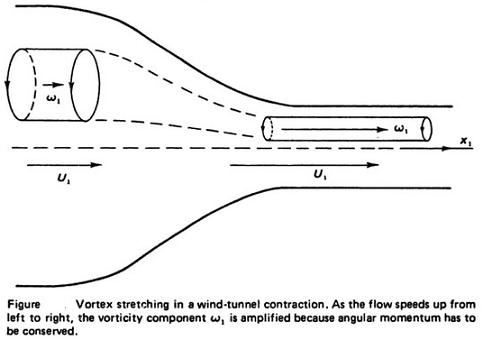Questions -
Q1. A qualitative estimate of the effect of a wind-tunnel contraction (Figure) on turbulent motion can be obtained by assuming that the angular momentum of eddies does not change through the contraction. Let the con-traction ratio, which is equal to the ratio of the mean velocity behind the contraction to that in front of the contraction, be equal to c. Show that the velocity fluctuations associated with an "eddy" aligned with the mean flow (as in Figure) increase by a factor c1/2 and that those associated with an eddy perpendicular to the mean flow decrease by a factor c. Compute the effect of the contraction on the relative turbulence intensity u/U. Estimate the effect of the contraction on the rate of decay of velocity fluctuations. Is it feasible to design a contraction such that the evolution of turbulent velocity fluctuations during the contraction can be ignored?

Q2. A fully developed turbulent pipe flow of fluid with a Prandtl number equal to one is being cooled by the addition of a small volume of slightly cooler fluid over a cross section. Estimate the initial temperature fluctuation level. How many pipe diameters downstream are required before the temperature fluctuations have decayed to 1% of the initial level? For the purpose of this calculation, it may be assumed that the mean velocity in the pipe is approximately independent of position. Also, an estimate for the dissipation rate c is needed; it can be obtained from momentum and energy integrals for pipe flow. For a prescribed decrease in mean temperature in the pipe, should one increase the volume flow of coolant and reduce the temperature difference or vice versa in order to reduce the temperature fluctuations?